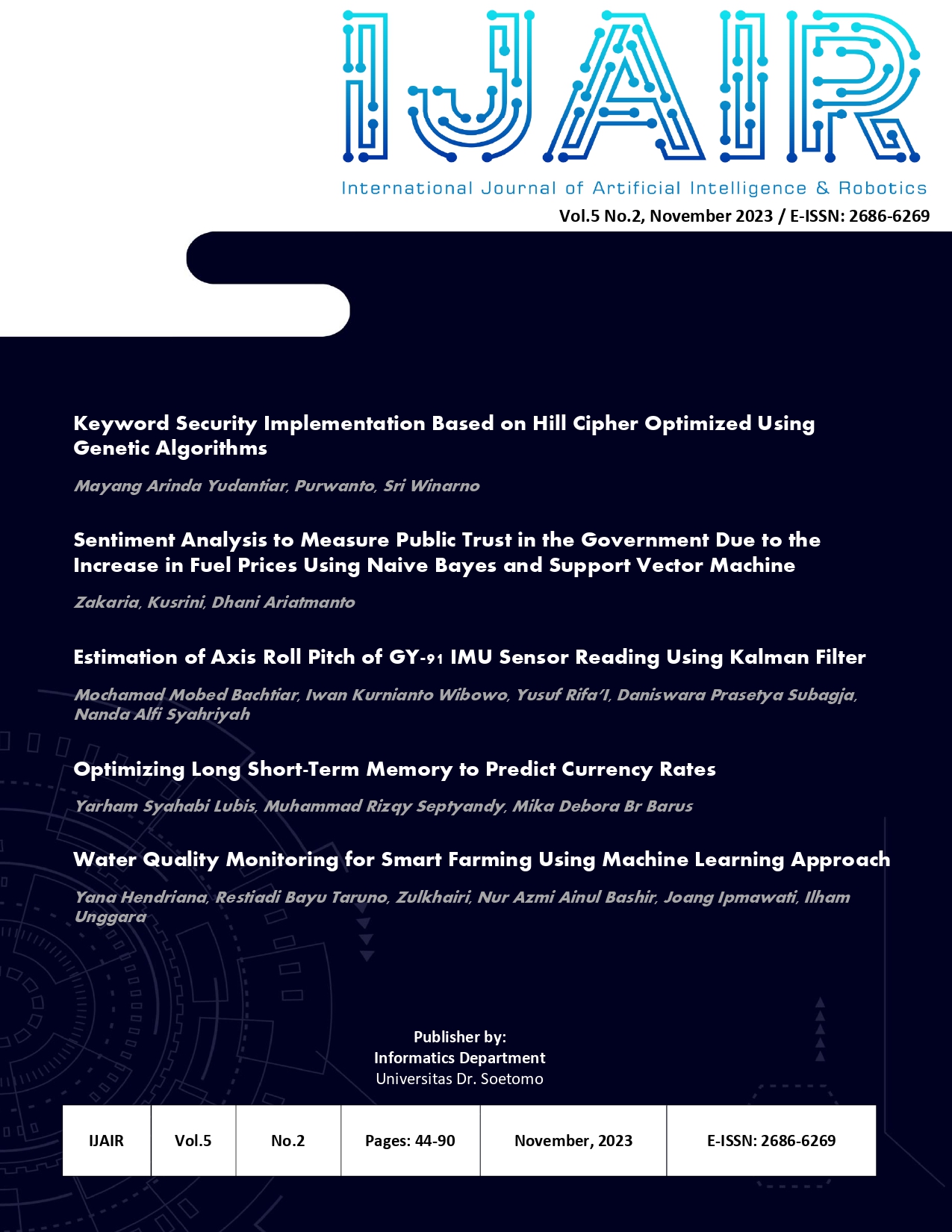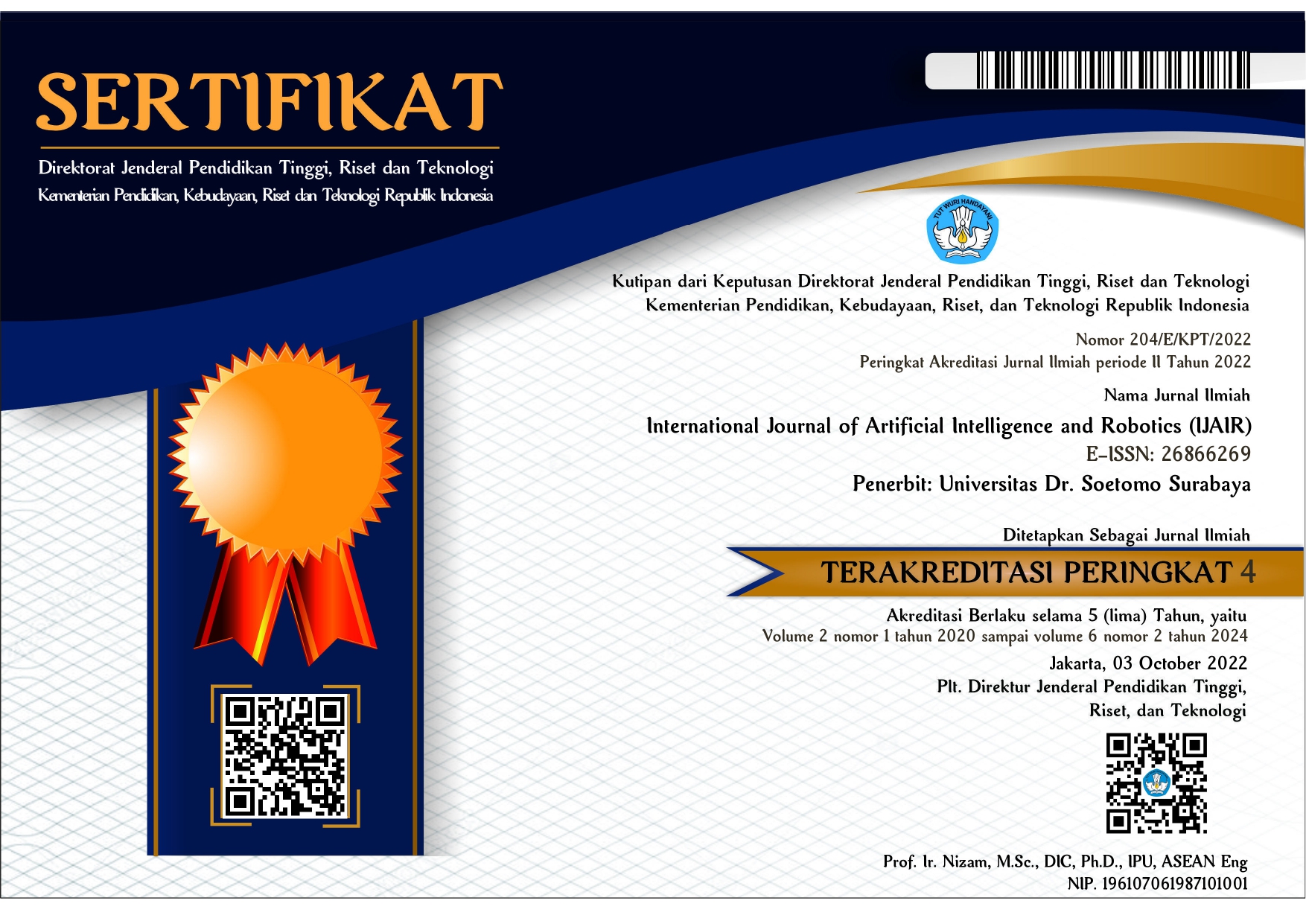Estimation of Axis Roll Pitch of GY-91 IMU Sensor Reading Using Kalman Filter
 Abstract views: 281
,
Abstract views: 281
,
 PDF downloads: 180
PDF downloads: 180
Abstract
The Inertial Measurement Unit (IMU) sensor is a tool used to measure the speed and acceleration of an object in 3 dimensions (x, y, z). IMU sensors are often used in robotics, drone control, autonomous vehicles, and augmented reality applications. Usually, the data obtained from the IMU sensor is contaminated by interference and noise, which can reduce measurement accuracy. Kalman Filter is a statistical method used to combine measurement data with a mathematical system model to produce better estimates. In the IMU context, the Kalman Filter removed interference and noise affecting acceleration and speed data so that IMU sensor data could be estimated more accurately. This algorithm predicts the next data state based on previous data and updates the prediction with new measurement data. The measurement implementation in this research is the IMU sensor on the GY-91 module to determine the object's tilt on the pitch, roll, and yaw axes during flight. The ARM STM32F407VGT6 microcontroller pin reads the sensor, and then the estimation and prediction process is carried out using the Kalman filter algorithm. With the parameters Kalman Measurement Error = 1, Estimation Error = 0.12, and Covariance Process = 0.4, it can predict the reading results from the IMU sensor well.
Downloads
References
K. Kefferpütz and K. McGuire, "Error-State Unscented Kalman-Filter for UAV Indoor Navigation," 2022 25th International Conference on Information Fusion (FUSION), Linköping, Sweden, 2022, pp. 01-08, doi: 10.23919/FUSION49751.2022.9841385.
P. Somers, J. Schüle, C. Tarín and O. Sawodny, "2D to 3D Segmentation: Inclusion of Prior Information using Random Walk Kalman Filters," 2021 43rd Annual International Conference of the IEEE Engineering in Medicine & Biology Society (EMBC), Mexico, 2021, pp. 4222-4225, doi: 10.1109/EMBC46164.2021.9629734.
C. T. Ginalih, A. S. Jatmiko and R. Darmakusuma, "Simple Application of Kalman Filter On a Moving Object in Unity3D," 2020 6th International Conference on Interactive Digital Media (ICIDM), Bandung, Indonesia, 2020, pp. 1-3, doi: 10.1109/ICIDM51048.2020.9339662.
A. Eman and H. Ramdane, "Mobile Robot Localization Using Extended Kalman Filter," 2020 3rd International Conference on Computer Applications & Information Security (ICCAIS), Riyadh, Saudi Arabia, 2020, pp. 1-5, doi: 10.1109/ICCAIS48893.2020.9096805.
Y. Luo, G. Ye, Y. Wu, J. Guo, J. Liang and Y. Yang, "An Adaptive Kalman Filter for UAV Attitude Estimation," 2019 IEEE 2nd International Conference on Electronics Technology (ICET), Chengdu, China, 2019, pp. 258-262, doi: 10.1109/ELTECH.2019.8839496.
A. P. Dhongade and M. A. Khandekar, "GPS and IMU Integration on an autonomous vehicle using Kalman filter (LabView Tool)," 2019 International Conference on Intelligent Computing and Control Systems (ICCS), Madurai, India, 2019, pp. 1122-1125, doi: 10.1109/ICCS45141.2019.9065851.
Z. Li, Z. Su and T. Yang, "Design of Intelligent Mobile Robot Positioning Algorithm Based on IMU/Odometer/Lidar," 2019 International Conference on Sensing, Diagnostics, Prognostics, and Control (SDPC), Beijing, China, 2019, pp. 627-631, doi: 10.1109/SDPC.2019.00118.
L. Lasmadi, F. Kurniawan, D. Dermawan and G. N. P. Pratama, "Mobile Robot Localization via Unscented Kalman Filter," 2019 International Seminar on Research of Information Technology and Intelligent Systems (ISRITI), Yogyakarta, Indonesia, 2019, pp. 129-132, doi: 10.1109/ISRITI48646.2019.9034570.
J. Onshaunjit and J. Srinonchat, "Nonlinear Kalman Filter Model for Balancing Optimization Gyro Robot," 2018 International Electrical Engineering Congress (iEECON), Krabi, Thailand, 2018, pp. 1-4, doi: 10.1109/IEECON.2018.8712267.
S. Habbachi, M. Sayadi, F. Fnaiech, N. Rezzoug, P. Gorce and M. Benbouzid, "Estimation of IMU orientation using linear Kalman Filter based on correntropy criterion," 2018 IEEE International Conference on Industrial Technology (ICIT), Lyon, France, 2018, pp. 1340-1344, doi: 10.1109/ICIT.2018.8352373.
H. C. Kam, Y. K. Yu and K. H. Wong, "An Improvement on ArUco Marker for Pose Tracking Using Kalman Filter," 2018 19th IEEE/ACIS International Conference on Software Engineering, Artificial Intelligence, Networking and Parallel/Distributed Computing (SNPD), Busan, Korea (South), 2018, pp. 65-69, doi: 10.1109/SNPD.2018.8441049.
H. . -Q. . -T. Ngo, T. . -P. Nguyen, V. . -N. . -S. Huynh, T. . -S. Le and C. . -T. Nguyen, "Experimental comparison of Complementary filter and Kalman filter design for low-cost sensor in quadcopter," 2017 International Conference on System Science and Engineering (ICSSE), Ho Chi Minh City, Vietnam, 2017, pp. 488-493, doi: 10.1109/ICSSE.2017.8030922.
A. Kaba, A. Ermeydan and E. Kiyak, "Model derivation, attitude control and Kalman filter estimation of a quadcopter," 2017 4th International Conference on Electrical and Electronic Engineering (ICEEE), Ankara, Turkey, 2017, pp. 210-214, doi: 10.1109/ICEEE2.2017.7935821.
M. Badeche and M. Benmohamed, "Real-Time Tracking for Augmented reality," 2006 2nd International Conference on Information & Communication Technologies, Damascus, Syria, 2006, pp. 1773-1778, doi: 10.1109/ICTTA.2006.1684654.
Copyright (c) 2023 Mochamad Mobed Bachtiar, Iwan Kurnianto Wibowo, Yusuf Rifa’I, Daniswara Prasetya Subagja, Nanda Alfi Syahriyah

This work is licensed under a Creative Commons Attribution-ShareAlike 4.0 International License.
Authors who publish with International Journal of Artificial Intelligence & Robotics (IJAIR) agree to the following terms:
-
Authors retain copyright and grant the journal right of first publication with the work simultaneously licensed under a Creative Commons Attribution License (CC BY-SA 4.0) that allows others to share the work with an acknowledgment of the work's authorship and initial publication in this journal.
-
Authors are able to enter into separate, additional contractual arrangements for the non-exclusive distribution of the journal's published version of the work (e.g., post it to an institutional repository or publish it in a book), with an acknowledgment of its initial publication in this journal.
-
Authors are permitted and encouraged to post their work online (e.g., in institutional repositories or on their website) prior to and during the submission process, as it can lead to productive exchanges, as well as earlier and greater citation of published work.















